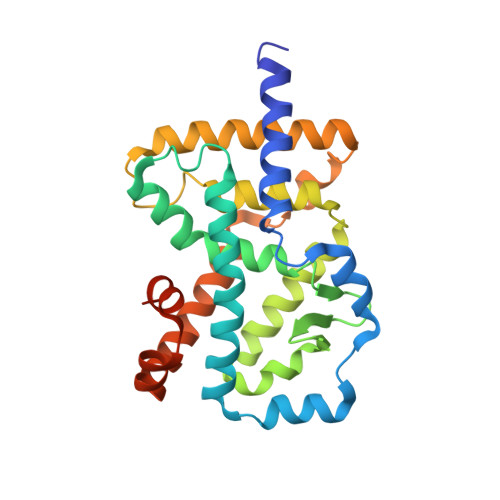Identification of Natural ROR gamma Ligands that Regulate the Development of Lymphoid Cells.
Santori, F.R., Huang, P., van de Pavert, S.A., Douglass, E.F., Leaver, D.J., Haubrich, B.A., Keber, R., Lorbek, G., Konijn, T., Rosales, B.N., Rozman, D., Horvat, S., Rahier, A., Mebius, R.E., Rastinejad, F., Nes, W.D., Littman, D.R.(2015) Cell Metab 21: 286-297
- PubMed: 25651181
- DOI: https://doi.org/10.1016/j.cmet.2015.01.004
- Primary Citation of Related Structures:
4S14, 4S15 - PubMed Abstract:
Mice deficient in the nuclear hormone receptor RORγt have defective development of thymocytes, lymphoid organs, Th17 cells, and type 3 innate lymphoid cells. RORγt binds to oxysterols derived from cholesterol catabolism, but it is not clear whether these are its natural ligands. Here, we show that sterol lipids are necessary and sufficient to drive RORγt-dependent transcription. We combined overexpression, RNAi, and genetic deletion of metabolic enzymes to study RORγ-dependent transcription. Our results are consistent with the RORγt ligand(s) being a cholesterol biosynthetic intermediate (CBI) downstream of lanosterol and upstream of zymosterol. Analysis of lipids bound to RORγ identified molecules with molecular weights consistent with CBIs. Furthermore, CBIs stabilized the RORγ ligand-binding domain and induced coactivator recruitment. Genetic deletion of metabolic enzymes upstream of the RORγt-ligand(s) affected the development of lymph nodes and Th17 cells. Our data suggest that CBIs play a role in lymphocyte development potentially through regulation of RORγt.
Organizational Affiliation:
The Kimmel Center for Biology and Medicine of the Skirball Institute, New York University School of Medicine, New York, NY 10016, USA. Electronic address: fsantof01@gmail.com.
















